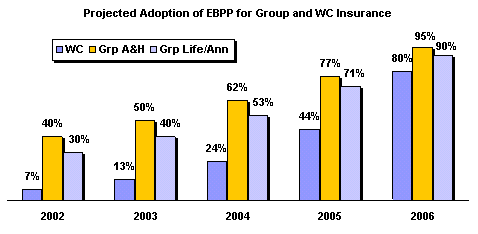E-Billing: A Strategic Necessity for Group Insurers
Abstract
US group and workers compensation insurers will spend approximately US$220 million on group e-billing projects over the next four years. Allowing customers to adjust rosters and re-calculate premiums is key right now, while EFT adoption is further off.
Insurers have been offering e-billing for several years, with strongest adoption by the large retail personal lines players. Often overlooked in discussions of e-billing and insurance, however, is the even greater current potential for e-billing to alleviate some of the pain points associated with list billing for group life/health and workers compensation insurers.
Celent’s new report, E-Billing for Group Insurers: A Strategic Necessity, finds extremely active interest in this space, and projects that by 2006, between 80% and 95% of carriers offering these products will offer e-billing, up from approximately 40% of group accident and health insurers and 30% of group life and annuities insurers today. Celent projects that US group and workers compensation insurers will spend approximately US$220 million on group e-billing projects over the next four years.

"By presenting information to the customer online instead of on paper and giving them the abilities to sort, store, analyze, and most importantly adjust bills themselves, carriers can eliminate unnecessary work, expense, and frustration for themselves and their customers," says senior analyst Matthew Josefowicz, lead author of the report. "Carriers who have embraced group e-billing have seen reductions in printing/mailing, reconciliation/processing, and customer service costs. But most carriers interviewed by Celent cited competitive pressure and strategic necessity to offer e-service as their primary motivators."
The report examines some of the pain points of list billing and how e-billing can relieve them. It looks at the key functionalities of group e-billing systems, strategies for driving customer adoption, and overviews of technical architectures. It also provides projections for adoption rates and technology spending by carriers, a brief review of some of the leading vendors in the space: Avolent, CheckFree, eDocs, Whitehill Technologies, and WorldGroup Consulting. There is also a case study of an group e-billing implementation at Harvard Pilgrim Health Care. The report concludes with key points for carriers considering launching e-billing for group insurance products.

